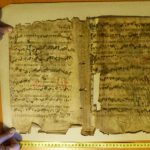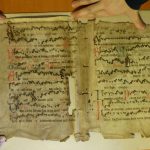The bifolio is one of three gradual-fragments which were used to bind the 16-17th century protocols of Kőszeg city, and whose mother codices were used at the Saint Jacob church of Kőszeg, according to Kilián Szigeti. Based on his opinion explained in detail in 1962 and confirmed in 1977 (see Bibliography) the graduals came with the liturgical equipment of the 15th century church in the first half of the century, supposedly from the Austrian region. According to Szigeti the chants preserved on the fragment follow the chant order of Salzburg and Passau mass sources, which is unsurprising, since Kőszeg (Güns) was a pawned land for Austria between 1445 and 1482, then from 1491 to 1647: as a part of Lower-Austria under Habsburg authority may have gotten its liturgical books from Austria.
In the days of Szigeti, in the ’60-s and ’70-s of the 20th century the fragment was kept in the National Archives of Szombathely with its host volume, the city protocols containing documents of the years 1583-1595. István Bariska made a list of the detached fragments of the Kőszeg Archives in his 1992 paper, among those was the gradual fragment already detached from its host volume, under the numbers 5 and 6. Janka Szendrei, who assumedly reviewed the musical fragments at Kőszeg in the second half of the ’80-s (as she does not mention them in her 1981 catalogue) in her handwritten notes gives a warning, that though the fragment was detached from its host volume, it had not gotten a separate shelf mark, furthermore, the host volume (the city protocols of Kőszeg) and the two fragments, which served as its cover were kept in two different institutions, separated from each other: the protocol was at Kőszeg, and the fragment was kept in the National Archives of Szombathely. At the time of our fieldwork, in November, 2019 we found the fragment in the Hungarian National Archives / Vas County Archives / Kőszeg Branch Archives.
The fragment preserved chants for the Sundays 9, 10, 14 and 15 post Pentecosten, completed with the first chant of the 11th Sunday (f. 1v) and the introit of the (September) Ember Days, written after the 15th Sunday (f. 2v). Both Kilián Szigeti and Janka Szendrei thought that the selection of mass chants and their arrangement is foreign to the traditions of Medieval Hungary. Assumedly, they based their suggestion on the alleluia series, which can be reconstructed from 4 chants – D9 Attendite, D10 Exsultate Deo + Sumite de psalmum, D14 Quoniam Deus, D15 Paratum cor –, which indeed does not occur in Hungarian sources, and whose parallels can be found, as mentioned, in sources from Salzburg and Passau. Their opinion can be somewhat further tinged based on the current richer knowledge of sources: the alleluia arrangement of the fragment can be found not only in South-German but sporadically in Bohemian and Moravian codices: refer to Missale notatum s. 13, Rajhrad, Library of the Benedictine Abbey R 396, f. 65v–66r és 68r–v, online: http://www.manuscriptorium.com/apps/index.php?envLang=en#search; Graduale s. 15, Archív mesta Brna, fond V 2 Svatojakubská knihovna, no. 1, f. 153v–159r.
Zsuzsa Czagány



